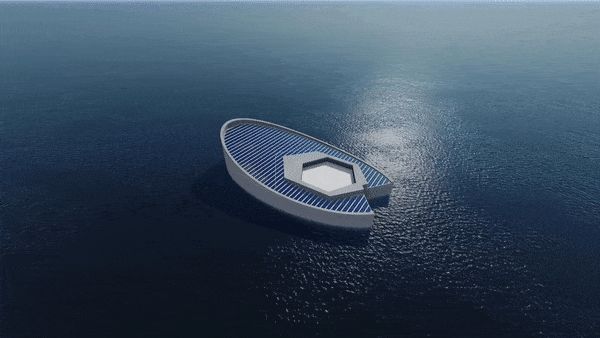
7th August 2019 Ice-making submarine could help restore Arctic A recent design competition hosted in Thailand included a geoengineering proposal to re-freeze the Arctic using fleets of ice-making submarines. Indonesian designer, Faris Rajak Kotahatuhaha, worked on the prototype with collaborators Denny Lesmana Budi and Fiera Alifa for an international competition organised by the Association of Siamese Architects. The team won second prize for their innovative concept – a floating "iceberg factory" that creates hexagonal blocks of ice in polar regions. The re-iceberg-isation process would involve a submersible vehicle able to capture and desalinate seawater, then freeze it in a 25 m (82 ft) cast with a volume of slightly over 2000 m³. To prevent melting before arrival at its destination, a cover would slide over to shield the ice from sunlight. The resulting block would be deployed where needed and left to float on the sea surface, with potential to be joined up with many others in a repeating jigsaw pattern. Over time, this could increase the albedo of the Arctic, restoring its function as a reflective layer for the planet, as well as providing habitats for polar bears and other ecological benefits. The iceberg factories would feature additional space in their hulls, allowing them to double as research vessels and laboratories or even underwater hotels, according to the design team.
However, some scientists appear sceptical that this proposal could work, since it would require many thousands of vessels to have a significant impact and would need to be carbon neutral. "It's like trying to save the sand castle you built at the beach using a dixie cup as the tide comes in," said Michael Mann, a director of Earth System Science at Penn State University and author of the famous "hockey stick" graph. Mark Serreze, director of the University of Colorado's National Snow and Ice Data Center, called the project "very interesting", but said it raised more questions than it answered: "What are you going to do, put out a flotilla of 10,000 submarines?" he said. "Who's going to build them and how much energy does it take, and how are the submarines powered?" Whatever the merits of this design, at least people are now beginning to think creatively about the looming crisis in the Arctic. The region is undergoing a catastrophic decline due to rapidly rising temperatures, with ice-free conditions predicted to emerge from 2020 to 2040.
Comments »
If you enjoyed this article, please consider sharing it:
|







